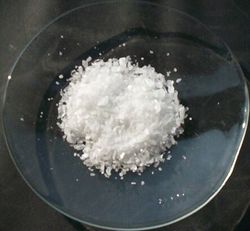Difference between revisions of "Boric acid"
| (2 intermediate revisions by the same user not shown) | |||
| Line 134: | Line 134: | ||
The easiest mode of acquisition is in department or hardware stores, where it is sold in relatively pure form as roach killer or other pesticides. Boric acid is also sold in pharmacies. | The easiest mode of acquisition is in department or hardware stores, where it is sold in relatively pure form as roach killer or other pesticides. Boric acid is also sold in pharmacies. | ||
| − | Lastly, it can also be very cheaply purchased online. | + | Lastly, it can also be very cheaply purchased online or from lab suppliers. |
==Preparation== | ==Preparation== | ||
| − | [[ | + | Mixing [[hydrochloric acid]] and [[borax]] will form boric acid, which, due to its low solubility will precipitate out in cold water. |
==Projects== | ==Projects== | ||
| Line 174: | Line 174: | ||
[[Category:Readily available chemicals]] | [[Category:Readily available chemicals]] | ||
[[Category:Irritants]] | [[Category:Irritants]] | ||
| + | [[Category:Essential reagents]] | ||
Latest revision as of 13:57, 18 November 2023
 Boric acid. From Wikipedia
| |
| Names | |
|---|---|
| IUPAC name
Boric acid
| |
| Other names
Boracic acid
Borofax Boron trihydroxide Boron(III) hydroxide Optibor Orthoboric acid Sassolite Trihydroxyborane Trihydrooxidoboron | |
| Properties | |
| H3O3B | |
| Molar mass | 61.83 g/mol |
| Appearance | White solid |
| Odor | Odorless |
| Density | 1.435 g/cm3 |
| Melting point | 170.9 °C (339.6 °F; 444.0 K) |
| Boiling point | 300 °C (572 °F; 573 K) (decomposition) |
| 2.52 g/100 ml (0 °C) 4.72 g/100 ml (20 °C) 5.7 g/100 ml (25 °C) 19.10 g/100 ml (80 °C) 27.53 g/100 ml (100 °C) | |
| Solubility | Soluble in ethanol, methanol Moderately soluble in ethylene glycol, glycerol, pyridine Slightly soluble in acetone, ethyl acetate |
| Solubility in ethanol | 9.44 g/100 ml (25 °C) |
| Solubility in methanol | 17.39 g/100 ml (25 °C) |
| Vapor pressure | ~0 mmHg |
| Acidity (pKa) | 9.24, 12.4, 13.3 |
| Hazards | |
| Safety data sheet | Sigma-Aldrich |
| Lethal dose or concentration (LD, LC): | |
| LD50 (Median dose)
|
2,660 mg/kg (rat, oral) |
| Related compounds | |
| Related compounds
|
Borax Boron trioxide |
| Except where otherwise noted, data are given for materials in their standard state (at 25 °C [77 °F], 100 kPa). | |
| Infobox references | |
Boric acid (H3BO3) is the most readily available boron compound.
Contents
Properties
Chemical
Boric acid is quoted as being "an acid by name only" and is even too weak to react with solids such as copper carbonate. It does not produce protons in water: it instead sequesters hydroxide ions from solution, forming H3O and B(OH)4-
Boric acid heated above 300 °C loses water to eventually form boron trioxide, which can be used in a thermite reaction with magnesium to produce elemental boron. Magnesium diboride is also produced as side product.
- 4 H3BO3 + 7 Mg → 2 B + MgB2 + 6 MgO + 6 H2O
It forms a trimethyl borate ester with methanol, which burns a brilliant green, and similarly forms triethyl borate with ethanol, which also burns green.
Reaction with alkali hydroxides will form the borate salts.
Boric acid reacts in alcoholic solution with two molecules of curcumin to form rosocyanine, a dark green ionic solid that forms deep red solutions.
Physical
Boric acid is only moderately soluble in water. It is also slightly soluble in lower alcohols and acetone.
Availability
The easiest mode of acquisition is in department or hardware stores, where it is sold in relatively pure form as roach killer or other pesticides. Boric acid is also sold in pharmacies.
Lastly, it can also be very cheaply purchased online or from lab suppliers.
Preparation
Mixing hydrochloric acid and borax will form boric acid, which, due to its low solubility will precipitate out in cold water.
Projects
- Making trimethyl borate
- Making boron trioxide, an intermediate in the production of elemental boron
- Make elemental boron
- Smelting flux
- Make boron and borosilicate glass
Handling
Safety
As it is a very weak acid, boric acid is non-corrosive, though it may irritate. Boric acid should not be consumed or inhaled in large amounts. Long term exposure should be limited.
Boric acid kills insects readily - it is often marketed as roach killer.
Storage
No special storage is required. Can be kept in any clean bottle or bag.
Disposal
Small amounts of boric acid can be poured down the drain, as is poses little toxicity to the environment. Larger quantities should be taken to disposal facilities. Waste boric acid can also be used as insecticide.